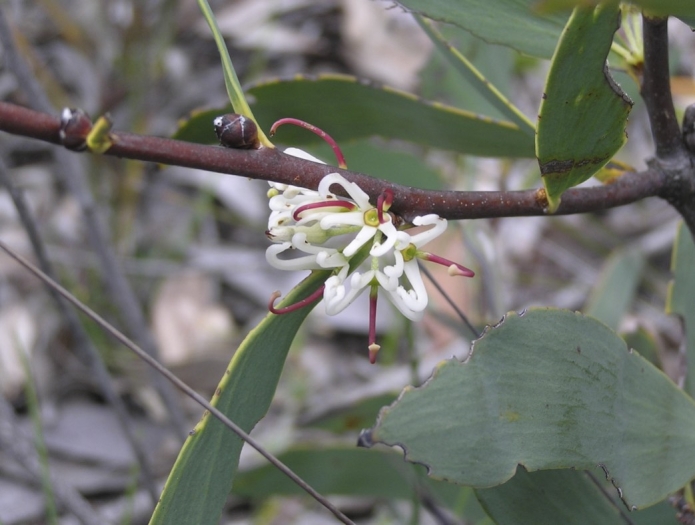Curved-Fruit Hakea
(Hakea cyclocarpa)
Curved-Fruit Hakea (Hakea cyclocarpa)
/
/

Ian McMaster
CC BY 3.0 au
Image By:
Ian McMaster
Recorded By:
Copyright:
CC BY 3.0 au
Copyright Notice:
Photo by: Ian McMaster | License Type: CC BY 3.0 au | License URL: https://creativecommons.org/licenses/by/3.0/au/deed.en | Uploader: Gderrin | Publisher: Wikimedia Commons | Title: Hakea_cyclocarpa.jpg | Notes: User created page with UploadWizard |


































Estimated Native Range
Summary
Hakea cyclocarpa, commonly known as Curved-Fruit Hakea, is an evergreen shrub endemic to the kwongan heathlands and mallee woodlands of Western Australia. It thrives in these nutrient-poor, sandy soils where it contributes to the region’s rich biodiversity. The shrub typically grows 1 to 2.5 meters (3.3 to 8.2 ft) tall with an upright, spindly form and lignotuberous base, which allows it to resprout after fire. Its smooth grey bark and smaller branches are often covered with soft matted white or rusty-colored hairs, adding to its unique texture. The inflorescence features 10-18 large white or creamy-white flowers with red-brown styles, each 13–14 mm (0.51–0.55 in) long, which are subtly fragrant and attract nectar-feeding birds and insects during their blooming period.
Curved-Fruit Hakea is valued for its ornamental qualities, including its striking flowers and interesting fruit which persist on the plant, adding year-round interest. It is drought and frost tolerant, making it suitable for water-wise gardens and areas with cold temperatures. This shrub is best suited for cultivation in full sun to semi-shade and requires well-drained soils, preferably mimicking its native sandy conditions. While it is generally low-maintenance, it can benefit from occasional pruning to maintain its shape and encourage denser growth.CC BY-SA 4.0
Curved-Fruit Hakea is valued for its ornamental qualities, including its striking flowers and interesting fruit which persist on the plant, adding year-round interest. It is drought and frost tolerant, making it suitable for water-wise gardens and areas with cold temperatures. This shrub is best suited for cultivation in full sun to semi-shade and requires well-drained soils, preferably mimicking its native sandy conditions. While it is generally low-maintenance, it can benefit from occasional pruning to maintain its shape and encourage denser growth.CC BY-SA 4.0
Plant Description
- Plant Type: Shrub
- Height: 3-8 feet
- Width: 1-1.5 feet
- Growth Rate: Moderate
- Flower Color: White
- Flowering Season: Winter
- Leaf Retention: Evergreen
Growth Requirements
- Sun: Full Sun
- Water: Low
- Drainage: Fast
Common Uses
Bird Garden, Butterfly Garden, Low Maintenance, Potted Plant, Rock Garden
Natural Habitat
Endemic to the kwongan heathlands and mallee woodlands of Western Australia
Other Names
Common Names: Ram’s-Horn, Wild Bean
Scientific Names: , Hakea cyclocarpa,
GBIF Accepted Name: Hakea cyclocarpa Lindl.